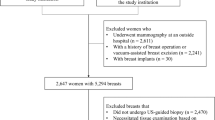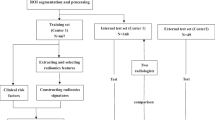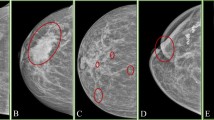Abstract
Objective
This paper presents a detailed study of fractal-based methods for texture characterization of mammographic mass lesions and architectural distortion. The purpose of this study is to explore the use of fractal and lacunarity analysis for the characterization and classification of both tumor lesions and normal breast parenchyma in mammography.
Materials and methods
We conducted comparative evaluations of five popular fractal dimension estimation methods for the characterization of the texture of mass lesions and architectural distortion. We applied the concept of lacunarity to the description of the spatial distribution of the pixel intensities in mammographic images. These methods were tested with a set of 57 breast masses and 60 normal breast parenchyma (dataset1), and with another set of 19 architectural distortions and 41 normal breast parenchyma (dataset2). Support vector machines (SVM) were used as a pattern classification method for tumor classification.
Results
Experimental results showed that the fractal dimension of region of interest (ROIs) depicting mass lesions and architectural distortion was statistically significantly lower than that of normal breast parenchyma for all five methods. Receiver operating characteristic (ROC) analysis showed that fractional Brownian motion (FBM) method generated the highest area under ROC curve (A z = 0.839 for dataset1, 0.828 for dataset2, respectively) among five methods for both datasets. Lacunarity analysis showed that the ROIs depicting mass lesions and architectural distortion had higher lacunarities than those of ROIs depicting normal breast parenchyma. The combination of FBM fractal dimension and lacunarity yielded the highest A z value (0.903 and 0.875, respectively) than those based on single feature alone for both given datasets. The application of the SVM improved the performance of the fractal-based features in differentiating tumor lesions from normal breast parenchyma by generating higher A z value.
Conclusion
FBM texture model is the most appropriate model for characterizing mammographic images due to self-affinity assumption of the method being a better approximation. Lacunarity is an effective counterpart measure of the fractal dimension in texture feature extraction in mammographic images. The classification results obtained in this work suggest that the SVM is an effective method with great potential for classification in mammographic image analysis.
Similar content being viewed by others
References
Cancer research UK (2008) online: http://www.cancerresearchuk.org/breastcancer/breast_cancer/. Accessed on 12 June 2008
Forrest A, Aitken R (1990) Mammography screening for breast cancer. Annu Rev Med 41: 117–132. doi:10.1146/annurev.me.41.020190.001001
Giger ML, Huo Z, Kupinski MA, Vyborny CJ (2000) Computer-aided Diagnosis in Mammography. In: Sonka M, Fitzzpatrick JM (ed) Handbook of medical imaging, vol 2. SPIE, Bellingham, pp 915–1004
Doi K, MacMahon H, Katsuragawa S, Nishikawa RM, Jiang Y (1997) Computer-aided diagnosis in radiology: potential and pitfalls. Eur J Radiol 31: 97–109. doi:10.1016/S0720-048X(99)00016-9
Astley SM, Gilbert FJ (2004) Computer-aided detection in mammography. Clin Radiol 59: 390–399. doi:10.1016/j.crad.2003.11.017
American College of Radiology (1998) Illustrated breast imaging reporting and data system (BI-RADS), 3rd edn. American College of Radiology, Reston
Knutzen AM, Gisvold JJ (1993) Likelihood of malignant disease for various categories of mammographically detected, nonpalpable breast lesions. Mayo Clin Proc 68: 454–460
Yankaskas BC, Schell MJ, Bird RE, Desrochers DA (2001) Reassessment of breast cancers missed during routine screening mammography: a community-based study. AJR Am J Roentgenol 177: 535–541
Burrell HC, Sibbering DM, Wilson ARM, Pinder SE, Evans AJ, Yeoman LJ, Elston CW, Ellis IO, Blamey RW, Robertson JFR (1996) Screening interval breast cancers: mammography features and prognostic factors. Radiology 199(7): 811–817
Burrell HC, Evans AJ, Wilson ARM, Pinder S (2001) False-negative breast screening assessment: what lessons can we learn? Clin Radiol 56: 385–388. doi:10.1053/crad.2001.0662
Sickles EA (1986) Mammographic features of 300 consecutive nonpalpable breast cancers. AJR Am J Roentgenol 146: 661–663
Broeders MJM, Onland-Moret NC, Rijken HJTM, Hendriks JHCL, Verbeek ALM, Holland R (2003) Use of previous screening mammograms to identify features indicating cases that would have a possible gain in prognosis following earlier detection. Eur J Cancer 39: 1770–1775. doi:10.1016/S0959-8049(03)00311-3
Mandelbrot BB (1983) The fractal geometry of nature. Freeman, New York
Pentland A (1984) Fractal-based description of natural scenes. IEEE Trans Pattern Anal Mach Intell 6(6): 661–674
Deering W, West BJ (1992) Fractal physiology. IEEE Eng Med Biol 11(2): 40–46. doi:10.1109/51.139035
Zheng L, Chan A (2001) An artificial intelligent algorithm for tumor detection in screening mammogram. IEEE Trans Med Imaging 20(7): 559–567. doi:10.1109/42.932741
Priebe CE, Solka JL, Lorey RA, Rogers GW, Poston WL, Kallergi M, Qian W, Clarke LP, Clark RA (1994) The application of fractal analysis to mammographic tissue classification. Cancer Lett 77: 183–189. doi:10.1016/0304-3835(94)90101-5
Li H, Liu KJR, Lo S-CB (1997) Fractal modelling and segmentation for the enhancement of microcalcifications in digital mammograms. IEEE Trans Med Imaging 16(6): 785–798. doi:10.1109/42.650875
Bocchi L, Coppini G, Nori J, Valli G (2004) Detection of single and clustered microcalcifications in mammograms using fractal models and neural networks. Med Eng Phys 26: 303–312. doi:10.1016/j.medengphy.2003.11.009
Tourassi GD, Delong DM, Floyd CE Jr (2006) A study on the computerized fractal analysis of architectural distortion in screening mammograms. Phys Med Biol 51: 1299–1312. doi:10.1088/0031-9155/51/5/018
Rangayyan RM, Prajna S, Ayres FJ, Desautels JEL (2008) Detection of architectural distortion in prior screening mammograms using Gabor filters, phase portraits, fractal dimension, and texture analysis. Int J CARS 2: 347–361. doi:10.1007/s11548-007-0143-z
Burgess AE (1999) Mammographic structure: data preparation and spatial statistics. Proc SPIE Int Soc Opt Eng 3661: 642–653
Heine JJ, Deans SR, Velthuizen RP, Clarke LP (1999) On the statistical nature of mammograms. Med Phys 26: 2254–2265. doi:10.1118/1.598739
Heine JJ, Velthuizen RP (2000) A statistical methodology for mammographic density detection. Med Phys 27: 2644–2651. doi:10.1118/1.1323981
Caldwell CB, Stapleton SJ, Holdsworth DW, Jong RA, Weiser WJ, Cooke G, Yaffe MJ (1990) Characterization of mammographic parenchymal pattern by fractal dimension. Phys Med Biol 35(2): 235–247. doi:10.1088/0031-9155/35/2/004
Byng JW, Boyd NF, Fishell E, Jong RA, Yaffe MJ (1996) Automated analysis of mammographic densities. Phys Med Biol 41: 909–923. doi:10.1088/0031-9155/41/5/007
Keller JM, Chen S, Crownover RM (1989) Texture description and segmentation through fractal geometry. Comput Vis Graph Image Process 45: 150–166. doi:10.1016/0734-189X(89)90130-8
Torres-Mejia G, De Stavola B, Allen DS, Perez-Gavilan JJ, Ferreira JM, Fentiman IS, dos Santos Silva I (2005) Mammographic features and subsequent risk of breast cancer: a comparison of qualitative and quantitative evaluations in the Guernsey prospective studies. Cancer Epidemiol Biomarkers Prev 14(5): 1052–1059. doi:10.1158/1055-9965.EPI-04-0717
de Melo RHC, Vieira EA, Conci A (2006) Characterizing the lacunarity of objects and image sets and its use as a technique for the analysis of textural patterns. ACIVS 2006, Belgium, pp 208–219
Gagnepain JJ, Roques-Carmes C (1986) Fractal approach to two-dimensional and three dimensional surface roughness. Wear 109: 119–126. doi:10.1016/0043-1648(86)90257-7
Sarkar N, Chaudhuri BB (1994) An efficient differential box-counting approach to compute fractal dimension of image. IEEE Trans Syst Man Cybern 24(1): 115–120. doi:10.1109/21.259692
Peleg S, Naor J, Hartley R, Avnir D (1984) Multiple resolution texture analysis and classification. IEEE Trans Pattern Anal Mach Intell 6(4): 518–523
Voss RF (1985) Random fractal forgeries. In: Earnshaw RA (eds) Fundamental algorithms for computer graphics. Springer, Heidelberg, pp 805–835
Peitgen H-O, Saupe D (1988) The science of fractal images. Springer, Heidelberg
Mandelbrot BB, Wallis JW (1968) Fractional Brownian motions, fractional noises, and applications. SIAM Rev 10: 422–437. doi:10.1137/1010093
Kube P, Pentland A (1988) On the imaging of fractal surfaces. IEEE Trans Pattern Anal Mach Intell 10(5): 704–707. doi:10.1109/34.6779
Chen C-C, Daponte JS, Fox MD (1989) Fractal feature analysis and classification in medical imaging. IEEE Trans Med Imaging 8(2): 133–142. doi:10.1109/42.24861
Plotnick RE, Gardner RH, Hargrove WW, Prestegaard K, Perlmutter M (1996) Lacunarity analysis: a general technique for the analysis of spatial patterns. Phys Rev E Stat Phys Plasmas Fluids Relat Interdiscip Topics 53(5): 5461–5468. doi:10.1103/PhysRevE.53.5461
Vapnik V (1998) Statistical learning theory. Wiley, New York
Smola AJ, Scholkopf B (1998) A tutorial on support vector regression. NeuroCOLT Tech Rep TR, Royal Holloway College, London
Chen SS, Keller JM, Crownover RM (1993) On the calculation of fractal features from images. IEEE Trans Pattern Anal Mach Intell 15: 1087–1090. doi:10.1109/34.254066
Suckling J, Dance DR, Lewis DJ, Blacker SG (1994) Parenchymal delineation by human and computer observers. In: Gale A, Astley SM, Dance DR, Cairns AY (ed) 2nd International workshop on digital mammography, Excerpta Medica, 1069, England, pp 315–324
Lilliefors H (1967) On the Kolmogorov-Smirnov test for normality with mean and variance unknown. J Am Stat Assoc 62: 399–402. doi:10.2307/2283970
Huang Q, Lorch JR, Dubes RC (1994) Can the fractal dimension of images be measured?. Pattern Recognit 27: 339–349. doi:10.1016/0031-3203(94)90112-0
Petrou M, Sevilla PG (2006) Image processing: dealing with texture. Wiley, New York
Metz CE (1986) ROC methodology in radiological imaging. Invest Radiol 21: 720–733. doi:10.1097/00004424-198609000-00009
Metz CE, Herman BA, Shen J-H (1998) Maximum-likelihood estimation of ROC curves from continuously-distributed data. Stat Med 17: 1033–1053 doi:10.1002/(SICI)1097-0258(19980515)17:9<1033::AID-SIM784>3.0.CO;2-Z
Du G, Yeo TS (2002) A novel lacunarity estimation method applied to SAR image segmentation. IEEE Trans Geosci Remote Sensing 40: 2687–2691
Author information
Authors and Affiliations
Corresponding author
Rights and permissions
About this article
Cite this article
Guo, Q., Shao, J. & Ruiz, V.F. Characterization and classification of tumor lesions using computerized fractal-based texture analysis and support vector machines in digital mammograms. Int J CARS 4, 11–25 (2009). https://doi.org/10.1007/s11548-008-0276-8
Received:
Accepted:
Published:
Issue Date:
DOI: https://doi.org/10.1007/s11548-008-0276-8




